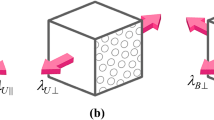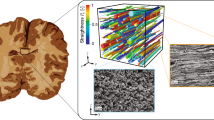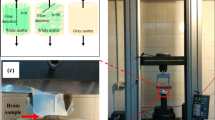Abstract
In this study, we propose a computational characterization technique for obtaining the material properties of axons and extracellular matrix (ECM) in human brain white matter. To account for the dynamic behavior of the brain tissue, data from time-dependent relaxation tests of human brain white matter in different strain rates are extracted and formulated by a visco-hyperelastic constitutive model consisting of the Ogden hyperelastic model and the Prony series expansion. Through micromechanical finite element simulation, a derivative-free optimization framework designed to minimize the difference between the numerical and experimental data is used to identify the material properties of the axons and ECM. The Prony series expansion parameters of axons and ECM are found to be highly affected by the Prony series expansion coefficients of the brain white matter. The optimal parameters of axons and ECM are verified through micromechanical simulation by comparing the averaged numerical response with that of the experimental data. Moreover, the initial shear modulus and the reduced shear modulus of the axons are found for different strain rates of 0.0001, 0.01, and 1 s−1. Consequently, first- and second-order regressions are used to find relations for the prediction of the shear modulus at the intermediate strain rates.

The applied procedure for characterization of brain white matter micro-level constituents. The macro-level experimental data in different strain rates are used in the context of simulation-based optimization to obtain the properties of axons and extracellular matrix material.









Similar content being viewed by others
References
Langlois JA, Rutland-Brown W, Wald MM (2006) The epidemiology and impact of traumatic brain injury: a brief overview. J Head Trauma Rehabil 21(5):375–378
Ratajczak M, Ptak M, Chybowski L, Gawdzińska K, Będziński R (2019) Material and structural modeling aspects of brain tissue deformation under dynamic loads. Materials 12(2):271
Arfanakis K, Haughton VM, Carew JD, Rogers BP, Dempsey RJ, Meyerand ME (2002) Diffusion tensor MR imaging in diffuse axonal injury. Am J Neuroradiol 23(5):794–802
Topal NB, Hakyemez B, Erdogan C, Bulut M, Koksal O, Akkose S, Dogan S, Parlak M, Ozguc H, Korfali E (2008) MR imaging in the detection of diffuse axonal injury with mild traumatic brain injury. Neurol Res 30(9):974–978
Ramzanpour M, Eslaminejad A, Hosseini-Farid M, Ziejewski M, Karami G (2018) Comparative study of coup and contrecoup brain injury in impact induced TBI. Biomed Sci Instrum 54(1):76–82
Saboori P, Sadegh A (2014) On the properties of brain sub arachnoid space and biomechanics of head impacts leading to traumatic brain injury. Adv Biomech Appl 1(4):253–267
Hosseini-Farid M, Ramzanpour M, Eslaminejad A, Ziejewski M, Karami G (2018) Computational simulation of brain injury by golf ball impacts in adult and children. Biomed Sci Instrum 54(1):369–376
El Sayed T, Mota A, Fraternali F, Ortiz M (2008) Biomechanics of traumatic brain injury. Comput Methods Appl Mech Eng 197(51–52):4692–4701
Farid, M. H., Eslaminejad, A., Ramzanpour, M., Ziejewski, M., and Karami, G., The strain rates of the brain and skull under dynamic loading, Proc. ASME 2018 International Mechanical Engineering Congress and Exposition, American Society of Mechanical Engineers, pp. V003T004A067-V003T004A067
Taylor PA, Ford CC (2009) Simulation of blast-induced early-time intracranial wave physics leading to traumatic brain injury. J Biomech Eng 131(6):061007
Hosseini-Farid M, Amiri-Tehrani-Zadeh M, Ramzanpour M, Ziejewski M, Karami G (2020) The strain rates in the brain, brainstem, Dura, and skull under dynamic loadings. Math Comput Appl 25(2):21
Laksari K, Sadeghipour K, Darvish K (2014) Mechanical response of brain tissue under blast loading. J Mech Behav Biomed Mater 32:132–144
Hosseini Farid, M., Ramzanpour, M., Ziejewski, M., and Karami, G., A constitutive material model with strain-rate dependency for brain tissue, Proc. ASME International Mechanical Engineering Congress and Exposition, American Society of Mechanical Engineers, p. V003T004A004
Ramzanpour, M., Hosseini-Farid, M., Ziejewski, M., and Karami, G., Microstructural hyperelastic characterization of brain white matter in tension, Proc. ASME International Mechanical Engineering Congress and Exposition, American Society of Mechanical Engineers, p. V003T004A009
Jahani B, Meesterb K, Wanga X, Brooksc A (2020) Biodegradable magnesium-based alloys for bone repair applications: prospects and challenges. Biomed Sci Instrum 56:292–304
Kallol K, Motalab M, Parvej M, Konari P, Barghouthi H, Khandaker M (2019) Differences of curing effects between a human and veterinary bone cement. Materials 12(3):470
Entezari A, Zhang Z, Sue A, Sun G, Huo X, Chang C-C, Zhou S, Swain MV, Li Q (2019) Nondestructive characterization of bone tissue scaffolds for clinical scenarios. J Mech Behav Biomed Mater 89:150–161
Hosseini-Farid M, Ramzanpour M, Ziejewski M, Karami G (2019) A compressible hyper-viscoelastic material constitutive model for human brain tissue and the identification of its parameters. Int J Non-Linear Mech 116:147–154
Mihai LA, Budday S, Holzapfel GA, Kuhl E, Goriely A (2017) A family of hyperelastic models for human brain tissue. J Mech Phys Solids 106:60–79
Budday S, Sommer G, Birkl C, Langkammer C, Haybaeck J, Kohnert J, Bauer M, Paulsen F, Steinmann P, Kuhl E (2017) Mechanical characterization of human brain tissue. Acta Biomater 48:319–340
Feng Y, Gao Y, Wang T, Tao L, Qiu S, Zhao X (2017) A longitudinal study of the mechanical properties of injured brain tissue in a mouse model. J Mech Behav Biomed Mater 71:407–415
Qiu S, Jiang W, Alam MS, Chen S, Lai C, Wang T, Li X, Liu J, Gao M, Tang Y, Li X, Zeng J, Feng Y (2020) Viscoelastic characterization of injured brain tissue after controlled cortical impact (CCI) using a mouse model. J Neurosci Methods 330:108463
Budday S, Nay R, de Rooij R, Steinmann P, Wyrobek T, Ovaert TC, Kuhl E (2015) Mechanical properties of gray and white matter brain tissue by indentation. J Mech Behav Biomed Mater 46:318–330
Feng Y, Lee C-H, Sun L, Ji S, Zhao X (2017) Characterizing white matter tissue in large strain via asymmetric indentation and inverse finite element modeling. J Mech Behav Biomed Mater 65:490–501
Hosseini-Farid, M., Rezaei, A., Eslaminejad, A., Ramzanpour, M., Ziejewski, M., and Karami, G., 2019 Instantaneous and equilibrium responses of the brain tissue by stress relaxation and quasi-linear viscoelasticity theory, Scientia Iranica, 26(issue 4: special issue dedicated to professor Abolhassan Vafai), pp. 2047-2056
Rashid B, Destrade M, Gilchrist MD (2012) Mechanical characterization of brain tissue in compression at dynamic strain rates. J Mech Behav Biomed Mater 10:23–38
Limbert G, Middleton J (2004) A transversely isotropic viscohyperelastic material: application to the modeling of biological soft connective tissues. Int J Solids Struct 41(15):4237–4260
Garnich MR, Karami G (2004) Finite element micromechanics for stiffness and strength of wavy fiber composites. J Compos Mater 38(4):273–292
Karami G, Garnich M (2005) Micromechanical study of thermoelastic behavior of composites with periodic fiber waviness. Compos Part B 36(3):241–248
Abolfathi N, Naik A, Sotudeh Chafi M, Karami G, Ziejewski M (2009) A micromechanical procedure for modelling the anisotropic mechanical properties of brain white matter. Comput Meth Biomech Biomed Eng 12(3):249–262
Arbogast KB, Margulies SS (1999) A fiber-reinforced composite model of the viscoelastic behavior of the brainstem in shear. J Biomech 32(8):865–870
Karami G, Grundman N, Abolfathi N, Naik A, Ziejewski M (2009) A micromechanical hyperelastic modeling of brain white matter under large deformation. J Mech Behav Biomed Mater 2(3):243–254
Meaney D (2003) Relationship between structural modeling and hyperelastic material behavior: application to CNS white matter. Biomech Model Mechanobiol 1(4):279–293
Ebenstein DM, Pruitt LA (2006) Nanoindentation of biological materials. Nano Today 1(3):26–33
Radmacher M (1997) Measuring the elastic properties of biological samples with the AFM. IEEE Eng Med Biol Mag 16(2):47–57
Javid S, Rezaei A, Karami G (2014) A micromechanical procedure for viscoelastic characterization of the axons and ECM of the brainstem. J Mech Behav Biomed Mater 30:290–299
Yousefsani SA, Shamloo A, Farahmand F (2018) Micromechanics of brain white matter tissue: a fiber-reinforced hyperelastic model using embedded element technique. J Mech Behav Biomed Mater 80:194–202
Hosseini-Farid M, Ramzanpour M, McLean J, Ziejewski M, Karami G (2019) Rate-dependent constitutive modeling of brain tissue. Biomech Model Mechanobiol 19:1–12
Hosseini-Farid M, Ramzanpour M, McLean J, Ziejewski M, Karami G (2020) A poro-hyper-viscoelastic rate-dependent constitutive modeling for the analysis of brain tissues. J Mech Behav Biomed Mater 102:103475
Liu Q, Liu J, Guan F, Han X, Cao L, Shan K (2019) Identification of the visco-hyperelastic properties of brain white matter based on the combination of inverse method and experiment. Med Biol Eng Comput 57(5):1109–1120
Miller K, Chinzei K (2002) Mechanical properties of brain tissue in tension. J Biomech 35(4):483–490
Forte AE, Gentleman SM, Dini D (2017) On the characterization of the heterogeneous mechanical response of human brain tissue. Biomech Model Mechanobiol 16(3):907–920
Naik A, Abolfathi N, Karami G, Ziejewski M (2008) Micromechanical viscoelastic characterization of fibrous composites. J Compos Mater 42(12):1179–1204
Abolfathi N, Naik A, Karami G, Ulven C (2008) A micromechanical characterization of angular bidirectional fibrous composites. Comput Mater Sci 43(4):1193–1206
Garnich MR, Karami G (2005) Localized fiber waviness and implications for failure in unidirectional composites. J Compos Mater 39(14):1225–1245
Karami G, Garnich M (2005) Effective moduli and failure considerations for composites with periodic fiber waviness. Compos Struct 67(4):461–475
Jahani B, Salimi Jazi M, Azarmi F, Croll A (2018) Effect of volume fraction of reinforcement phase on mechanical behavior of ultra-high-temperature composite consisting of iron matrix and TiB2 particulates. J Compos Mater 52(5):609–620
Yousefsani SA, Farahmand F, Shamloo A (2018) A three-dimensional micromechanical model of brain white matter with histology-informed probabilistic distribution of axonal fibers. J Mech Behav Biomed Mater 88:288–295
Budday S, Sommer G, Haybaeck J, Steinmann P, Holzapfel G, Kuhl E (2017) Rheological characterization of human brain tissue. Acta Biomater 60:315–329
Rios LM, Sahinidis NV (2013) Derivative-free optimization: a review of algorithms and comparison of software implementations. J Glob Optim 56(3):1247–1293
Alimo SR, Beyhaghi P, Bewley TR (2019) Delaunay-based global optimization in nonconvex domains defined by hidden constraints, Evolutionary and deterministic methods for design optimization and control with applications to industrial and societal problems. Springer, Berlin, pp 261–271
Alimo, S. R., Beyhaghi, P., and Bewley, T. R., Optimization combining derivative-free global exploration with derivative-based local refinement, Proc. 2017 IEEE 56th Annual Conference on Decision and Control (CDC), pp. 2531–2538
Eberhart, R., and Kennedy, J., Particle swarm optimization, Proc. Proceedings of the IEEE international conference on neural networks, Citeseer, pp. 1942-1948
Du K-L, Swamy M (2016) Search and optimization by metaheuristics, techniques and algorithms inspired by nature. Birkhauser, Basel
Ramzanpour, M., Hosseini-Farid, M., Ziejewski, M., and Karami, G., 2020, A constrained particle swarm optimization algorithm for hyperelastic and visco-hyperelastic characterization of soft biological tissues Int J Comput Methods Eng Sci Mech, pp. 1-16
Ramzanpour, M., Hosseini-Farid, M., Ziejewski, M., and Karami, G., Particle swarm optimization method for hyperelastic characterization of soft tissues, Proc. ASME International Mechanical Engineering Congress and Exposition, American Society of Mechanical Engineers, p. V009T011A028
Hosseini Farid, M., Ramzanpour, M., Ziejewski, M., and Karami, G., A biphasic viscoelastic constitutive model for brain tissue, Proc. ASME International Mechanical Engineering Congress and Exposition, American Society of Mechanical Engineers, p. V003T004A005
Author information
Authors and Affiliations
Corresponding author
Additional information
Publisher’s note
Springer Nature remains neutral with regard to jurisdictional claims in published maps and institutional affiliations.
Rights and permissions
About this article
Cite this article
Ramzanpour, M., Hosseini-Farid, M., McLean, J. et al. Visco-hyperelastic characterization of human brain white matter micro-level constituents in different strain rates. Med Biol Eng Comput 58, 2107–2118 (2020). https://doi.org/10.1007/s11517-020-02228-3
Received:
Accepted:
Published:
Issue Date:
DOI: https://doi.org/10.1007/s11517-020-02228-3




